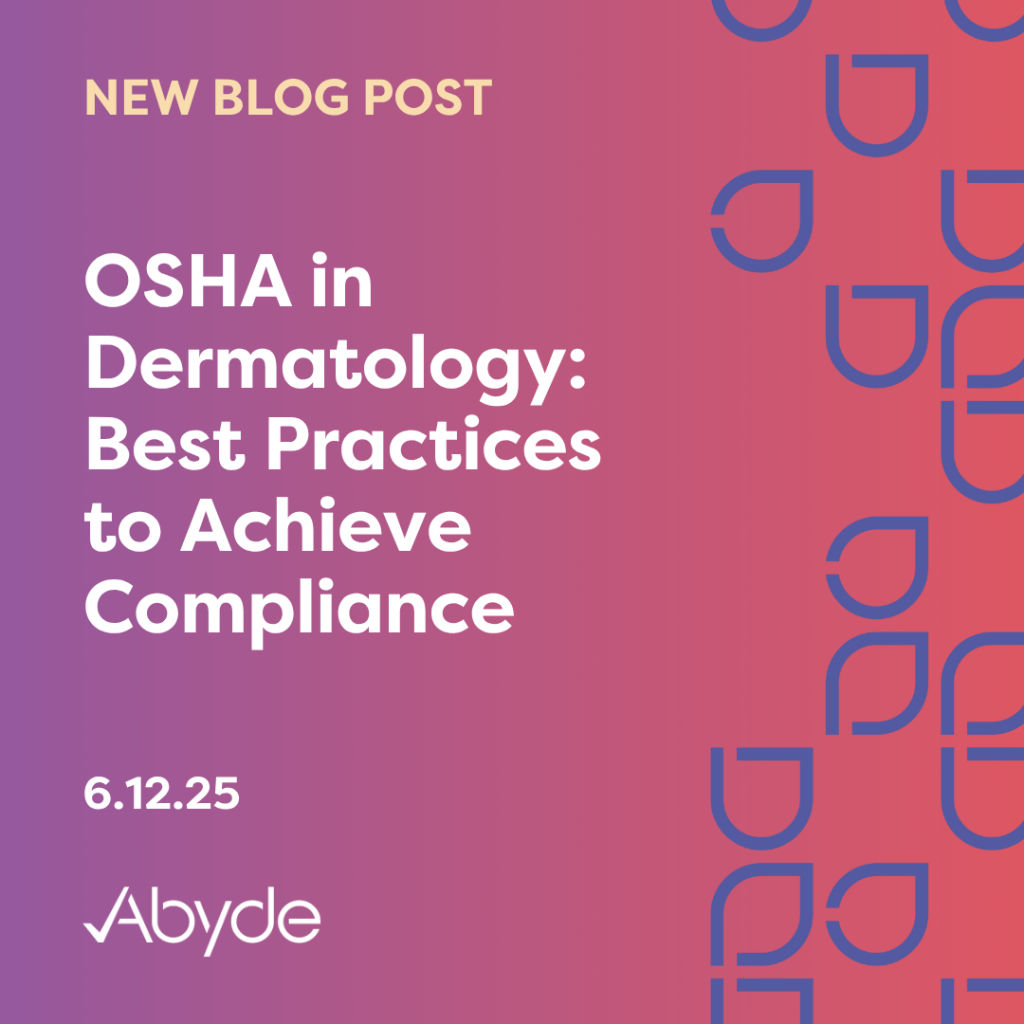June 12, 2025 While working in a dermatology office might have you focused on taking care of your patients’ skin, your health should be the first priority. It’s easy to incorrectly assume a dermatology office is a relatively “safe” healthcare environment. After all, we’re not typically dealing with the same acute emergencies as an ER. Dermatology presents many challenges when working with patients, such as lasers, sharp instruments, chemicals, potential exposure to bloodborne pathogens, and more. With these unique challenges, your practice must be aware of the safeguards the Occupational Safety and Health Administration (OSHA) requires. More than Skin Deep: Facility Risk Assessment An annual Facility Risk Assessment (FRA) is the foundation of your OSHA compliance program. The FRA is a thorough assessment of the healthcare hazards your practice might face. This assessment spans from your staff is trained, to unique equipment you might use, how situations are prevented, and even how management handles workplace safety. Since this is an annual requirement, this assessment must be kept current. If your practice introduces anything new that might heighten risk, this needs to be documented. For instance, if your practice begins offering laser treatments, this must be mentioned in the FRA and also staff must be trained on how to use it safely. By reviewing and addressing potential vulnerabilities in your practice, you can mitigate risks and ultimately keep patients safe. Personal Protective Equipment (PPE) in Dermatology: Your First Line of Defense While you advise patients on sun protection, remember that your staff’s skin needs protection, too. Always ensure that it remains covered with Personal Protective Equipment (PPE). PPE, like gloves and masks, are essential barriers that keep your team safe. Your practice must supply this PPE and provide comprehensive training on how to use it correctly. For instance, when a staff member is with a patient, a new set of gloves is always required. From putting them on to how they must be disposed of, these are all critical ways to keep staff members safe. Depending on the treatment, your staff may also need eye protection. As a result, it’s essential to review all available forms of PPE with staff before they start working with patients. Dermatology Laser Safety When it comes to lasers in your dermatology practice, preparation is paramount. It’s not enough to just have the equipment; you need to ensure every team member is properly trained and fully aware of the risks associated with these powerful devices. Once again, proper PPE is vital, such as eyewear and gloves. Additionally, the room where the laser is being used must adhere to safety guidelines, including not having any reflective surfaces for the laser to shine off. Your practice should designate a Laser Safety Officer to oversee and enforce compliance. This staff member is likely already your OSHA Safety Officer, or OSO. This Laser Safety Officer needs to ensure staff is routinely trained on lasers, especially if new equipment is being used. For staff safety, the laser device must be off when not in use. While laser treatments offer dermatologists innovative possibilities, proper staff training always remains crucial. Keeping Your Dermatology Practice Safe Ensuring the safety of your dermatology practice is not just about compliance; it’s about fostering a secure environment for both your dedicated staff and your valued patients. Your practice can proactively address potential hazards by diligently conducting annual facility risk assessments, consistently utilizing appropriate personal protective equipment, and prioritizing comprehensive training. With the right solution, your practice can streamline these requirements. Smart software can utilize the answers from your FRA and provide thorough policies and procedures and recommended training. A safe practice is a successful practice. To see how you can streamline compliance for your practice, schedule a meeting with a compliance expert today.
Kickstart your OSHA Compliance Program with a Facility Risk Assessment
October 11, 2022 If you are familiar with OSHA compliance, you may know that you need to complete a Facility Risk Assessment, otherwise known as a Workplace Hazard Assessment. Tomato, toe-mat-oh, right? Despite the differing names, it’s important to know that this assessment helps your organization to identify, minimize and eliminate hazards in the workplace with the goal of providing a safe and healthful work environment for all employees. Think of your Facility Risk Assessment (FRA) as the meat and potatoes of your entire OSHA compliance program. This is a baseline survey of all the hazards in your workplace. Without properly identifying, and more importantly, documenting all hazards within your organization, you cannot move forward with the rest of your OSHA compliance program and cannot show that there is a culture of compliance within your organization. Additionally, in the case of an investigation, the FRA is going to be the first thing the government asks for, so that is why it is so important it is completed first. What kind of questions does your FRA need to include? Just as there is not a single recipe for a savory steak and potato meal, there is no single checklist to follow when it comes to completing a Risk Assessment for your organization. However, OSHA does recommend incorporating 7 core elements as part of your Facility Risk Assessment: Once you have completed your Facility Risk Assessment, you should not tuck it into a folder and forget about it. Your FRA must be reviewed periodically to ensure that it is up to date and accurately reflects all processes and controls within your organization. It’s also important to keep in mind that all employees should be involved in the process of mitigating hazards identified from your FRA. What’s the best way to tackle a Facility Risk Assessment? If your organization has not completed an FRA before or if you have but not sure if it was thorough, using an outside organization will help to ensure all areas of the FRA are fully completed and documented accordingly. A third party can also help add new areas and questions into the FRA that reflect changing regulations. Are you looking for help kickstarting your OSHA compliance program? Reach out to Abyde today for a customized, easy to complete FRA that is tailored to you and your organization.

